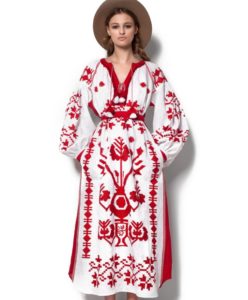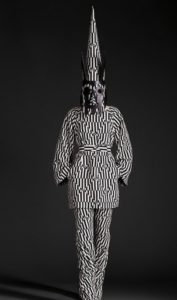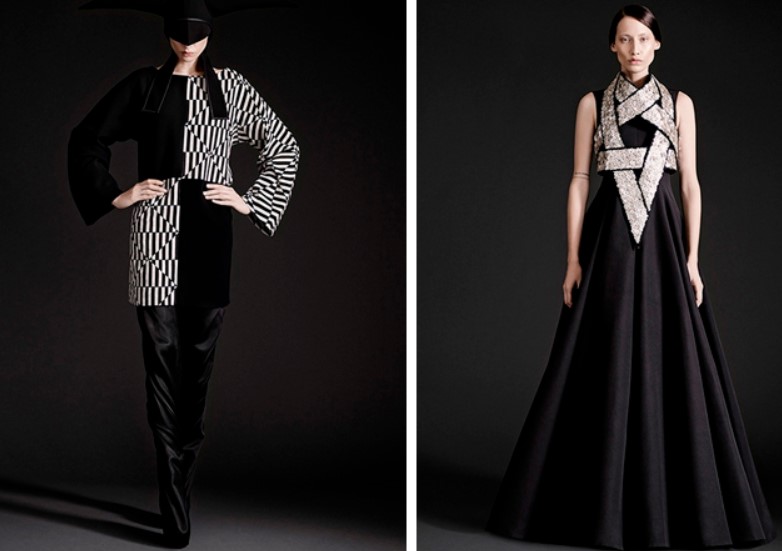Folk, ethno, boho - words that have not disappeared from the glossy for the last 5 years. The constancy is explained by the rich mythological and pagan heritage. This is a huge niche and a bottomless well from which you can endlessly draw inspiration. And fashion houses know this, because they have again included outfits with traditional ethnic characteristics in their collections. If you have not yet purchased a modern version of the Slavic sundress and coat in the Japanese style, then immediately rush to the store.
What pagan motifs are designers inspired by?
 Folklore, mythology, the pre-Christian Slavic period, witchcraft in Europe and even idolatry are the proven “muses” of composers, architects and couturiers. From them they draw patterns and ways of combining materials, the outlines of hats and clothing, inscriptions and colors.
Folklore, mythology, the pre-Christian Slavic period, witchcraft in Europe and even idolatry are the proven “muses” of composers, architects and couturiers. From them they draw patterns and ways of combining materials, the outlines of hats and clothing, inscriptions and colors.
Sometimes borrowing goes beyond boundaries and then the collection turns out to be shocking, and the models representing it turn into indigenous inhabitants of the regions, recognizable mythical heroes or frightening creatures. In other cases, only isolated features are adopted. This approach usually results in the creation of objects that not only look interesting, but can also be used in everyday life.
Slavic roots of modern fashion trends
Characteristic features of Slavic ethno:
 Colors: crimson, black, rich pink, terracotta, red, white, blue, blue, green, gold.
Colors: crimson, black, rich pink, terracotta, red, white, blue, blue, green, gold.- Patterns: geometric, plant (including flowers and berries), animalistic (including images of birds, both real and fabulous).
- Finishing: stones, fringe, embroidery, fur, ribbons.
- Materials: cotton, cloth, lace, velvet, satin, wool, silk.
- Accessories: wooden, metal and textile jewelry with decor from beads, engraving, scattering of stones, varnish.
- Makeup: thick eyebrows, long eyelashes, apples on the cheeks.
The Slavic boho style is characterized by satin stitch and cross stitch embroidery, colorful printed patterns, an abundance of fasteners (primarily buttons and laces), and multi-layered. Women are offered colorful sundresses with short sleeves or with wide straps. The item can be either very light (for example, satin) or insulated, designed for use in harsh winters. Length: floor Waistline: high, clearly defined and often equipped with a fixing ribbon (wide). Alternative women's clothing: a bell skirt and a long, loose-fitting dress. The hem of the latter option is often richly and elaborately decorated.
Types of warm women's clothing:
- short fur coats;
- vests with fur trim;
- sleeveless vests (the sleeveless cape looked like a raincoat);
- fur coats made of sable, ermine, fox, marten;
- telogrey;
- jackets with fur.
 Not all outerwear items have clasps. Some original Russian clothes for the street were worn exclusively open. If necessary, they were simply belted with a wide belt. Well, specifically, fur coats were tied with laces, leather or textile.
Not all outerwear items have clasps. Some original Russian clothes for the street were worn exclusively open. If necessary, they were simply belted with a wide belt. Well, specifically, fur coats were tied with laces, leather or textile.
Another characteristic feature of the Slavic style is combination of different materials within one thing (the more elegant the item was, the more good materials went into it). The world's fashion industry gurus have been fascinated by this same trend for many years now. Among the trends was a scarf with dangles. Moreover, it is used not only in combination with a boho dress, but also in conjunction with rough or street clothes. For example, together with short denim shorts, a loose T-shirt, a hat and chunky boots.
Of the Slavic motifs, designers especially like berry, solar, bird and flower (large red buds) patterns. Sundresses and dresses with similar patterns for 2019 were offered by Oscar de la Renta, Anna Sui, Etro, Ulla Johnson. The latest American designer takes not only motifs, but also forms from Slavic ethno. For example, she has a lot of shirts.
Constantly flashing on the catwalks outfits with Gzhel, Khokhloma. It is extremely common to see white clothing covered with bluish-blue painting. Its key object is bud of a mature tea rose. World fashion icons are almost more actively turning to Russian woven lace. Items made from Vologda lace were once presented in Valentino’s collections. Today, crocheted outfits are offered by Michael Kors, Jill Sanders, Chloe, Carolina Herrero and Simone Rocha.
Ethnic style and its character
At the September fashion show in Milan - it was there that the trends relevant for 2019 were shown - the typical Russian ethno color scheme prevailed. The emphasis was on blue, pink, purple, red, black, white, emerald. Slavic prints included: floral, geometric, Gzhel. Decor: pendants, fringe, embroidery.
Important! The designers indicated that embroidery in folk style will be at the peak of fashion in the summer of 19. Well, in the off-season and winter you will need to wear blouses, scarves and jackets with ethnic patterns.
 Quite a lot of things were made from brocade, beloved by the Slavs. And not from a single color, but covered with thematic “Russian” patterns. Similar outfits were presented by: Dolce and Gabbana, Michael Kors, Louis Vuitton.
Quite a lot of things were made from brocade, beloved by the Slavs. And not from a single color, but covered with thematic “Russian” patterns. Similar outfits were presented by: Dolce and Gabbana, Michael Kors, Louis Vuitton.
Not a single Slavic culture. It is clear that global designers have been influenced by traditional japanese culture. If you want to be on trend, watch the movie “Memoirs of a Geisha” and feel free to go shopping. On store shelves you will find things with African and Indian motifs.
Shocking and scary pentagrams
Paganism is not only Russian protective embroidery and details characteristic of the pre-Christian period, but also evil spirits, covens of witches, as well as satanic paraphernalia. Gothic and other manifestations of dark European mysticism inspire designers to create:
 loose clothing (fits perfectly into the trend that requires you to wear things several sizes larger);
loose clothing (fits perfectly into the trend that requires you to wear things several sizes larger);- things with a geometric white and black pattern that repeats itself many times and therefore refracts the picture;
- costumes with bull and goat heads (a typical personification of Satan, widely used in dark masses);
- dresses vaguely reminiscent of those worn by American women during the Witch Hunt;
- headdresses imitating tall, pointed caps with slits for the eyes (today the horrifying cap is worn during Holy Week, but during the Inquisition this was how criminals were dressed);
- headdresses imitating a pointed witches hat.
- decorations in the form of pictograms (for example, a five-pointed star inscribed in a special way and placed inside or outside a circle) and inscriptions in Latin (for example, words from a tattoo placed on the arm of Baphomet).
Important! Collections that convey an atmosphere of agency and idolatry often have signs of a constructive style. There is an emphasis on geometry, refracting figures, and on the psychedelic play of colors.
Models who wear such clothes must exert an intimidating and overwhelming influence on the public. That’s why they rise so much above the audience due to special shoes. However, shoes with extra-high heels, which are familiar to the average person, can undermine the overall atmosphere of mystery and mysticism, which is why designers skillfully disguise and hide shoes, making them invisible and merging with the general background.































 0
0





